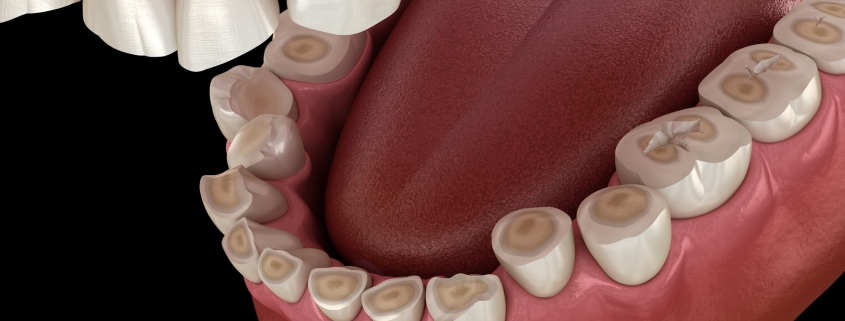Causes of enamel erosion
Enamel is the outermost layer of teeth and the hardest tissue in the human body. This layer is white and surrounds the crown of the tooth. Normally, a very small amount of tooth enamel is damaged during the day and night, but with good oral hygiene, it is not too late to restore the enamel minerals. But sometimes, due to factors such as poor oral hygiene, the enamel may be damaged and need to be repaired. What you read in this article is complete information about enamel erosion and its repair method.
Erosion is usually the result of destruction of tooth enamel by acidic activity. The following are involved in oral acidification, erosion, and enamel analysis:
Excessive alcohol consumption
Diet containing starch and sugar
Dry mouth
Decreased saliva
Acid reflux disease (GERD) and other gastrointestinal problems
Genetics
Medications such as aspirin and antihistamines
In addition to the above, environmental factors such as daily friction, corrosion and abrasion can also cause enamel erosion. So, even if you eat right, avoid sugar, do not take medication regularly, and are generally in good health, you may still have enamel resorption.
What are the symptoms of enamel erosion?
Signs that your enamel is eroding include:
Fractures and fillings: The edges of worn teeth may have minor fractures and irregularities.
Discoloration: A decayed or damaged tooth has a dark yellow color.
Glazing: The tooth finds a shape at its edges called glass.
Sensitivity: Eating sweets or foods that are relatively hot or cold may be painful for people who experience enamel resorption. If the pain is severe, the enamel may be completely worn out.
What can we do to treat and repair decayed enamel?
The first thing you need to know about tooth enamel is that if the enamel is degraded and its thickness is greatly degraded, it can no longer be repaired. In other words, he can not repair himself. Because there is no living cell inside the structure of the enamel to regenerate and repair the enamel.
As a result, when we are faced with enamel resorption, we should refer to a dentist or restorative and cosmetic specialist to repair the enamel with dental methods. In the following, you will get acquainted with 3 methods of repairing and restoring tooth enamel.
Dental bonding composite
Composite is one of the most common materials used in the dental industry. This substance is used for various purposes. But its most important use is to repair damaged and decayed teeth.
The dental composite is attached to a tooth that has suffered from enamel erosion by a restorative and cosmetic specialist and is hardened with the help of special light or heat. Dental composite is very durable and unlike other restorative materials, it has a very good bonding power to the teeth.
Dental veneers
Veneers are thin scales that attach to the front of teeth. The most well-known dental veneers are dental laminates and composite veneers, which are mostly used for their aesthetic aspects. But they can also be used to repair and protect decayed enamel. After composite bonding, veneers are the best method for treating tooth enamel erosion.
To install dental laminate, it is necessary to shave some of the thickness of the enamel so that the laminates stick to the front of the teeth.
To install composite veneers, there is no need to shave more enamel and they are attached to the front of the teeth only in the dentist’s office.
Dental crowns
Veneers are crown-shaped caps that attach to our teeth near the gum line. When much of the enamel is gone and the veneer and composite bonding of the tooth cannot be repaired, the only way left is to use a veneer.
Teeth that have recently been Denervated or are very weak are usually protected by a veneer.
What can we do to care for and protect our enamel?
Apart from brushing and flossing, there are many things you can do to prevent enamel erosion. Some of these simple and preventative measures are:
Eat a healthy diet
Eliminate acidic foods and beverages such as soft drinks, fruit juices and citrus fruits from your diet, or rinse your mouth with water immediately after eating or drinking such products. Be careful not to brush your teeth immediately after eating such foods. Because the rate of tooth enamel erosion increases and makes it more difficult to repair.
Be careful in choosing your snacks
If you can, avoid snacks throughout the day and eat only the main meals. If you have a strong desire for food and snacks, try chips, fast food, breads, dried fruits and…. Eat less because consuming them increases the production of acid and starch and increases the chances of tooth enamel decay. Rinse your mouth thoroughly with water if you consume these foods.
Drink more water
Saliva plays an important role in maintaining the health of the mouth and especially the teeth. Saliva removes plaque and helps to neutralize the environment inside the mouth. To reduce saliva in your mouth, try to drink plenty of water daily.
Chew gum
Chew sugar-free gum between meals. Chewing gum increases saliva production, which helps strengthen teeth and reduces the amount of acid in food and beverages. Buy chewing gum that contains xylitol because this sugar is very good for teeth.
Talk to your dentist
The best person who can help you maintain good oral health is your dentist. Be sure to talk to a dentist if you are afraid of enamel erosion or tooth decay.
Consider preventive dental treatments
For your children, you can also do fluoride therapy or fissure sealant at an early age to help prevent tooth decay or enamel erosion.

